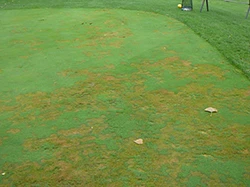
Rob Golembiewski, Ph.D., is part of the Bayer Green Solutions Team
The Challenge
Pythium turf diseases can cause significant problems on golf courses. Pythium species can cause several turf diseases, but during this time of the year low-temperature blight and root rot are of real concern. These diseases favor different conditions, and can kill turf in as little as 24 hours if left unchecked. It’s important to understand the risk factors, best methods of prevention, as well as diagnosis and treatment in the event of an outbreak.
Pythium at a glance
| Pythium Blight (low-temperature) | Pythium Root Rot | |
| Primary species involved | P. graminicola, P. ultimum |
P. graminicola, P. ultimum, P. torulosum, P. vanterpoolii + many others |
| Typical conditions for disease development |
Daytime temperatures below 55-60 F Cool and wet |
Low plant growth potential in cold or hot conditions and wet soils Worst on stressed turfgrass |
| Cultural conditions favoring disease | Excessive nitrogen fertility, poor soil drainage and air movement | Poor soil drainage and air movement, plant stress |
| Primary location | Foliage and crowns | Roots |
| Symptoms, Detection, Diagnosis Pythium Blight Symptoms appear as sunken, greasy black patches and streaks on turf that can take on a reddish orange to dark gray color (Figure 1). Affected turf is often matted and has a water-soaked appearance. White, cottony mycelium may be present in the early morning on affected areas, or after incubation of samples overnight in a moist chamber or plastic bag. |
Figure 1: Reddish orange color and irregular pattern of symptoms associated with Pythium blight on a creeping bentgrass tee. Photo: Derek Settle, Ph.D., Bayer CropScience |
Blight can kill turf in 24-48 hours and preventive measures are key for controlling this disease. Different species cause blights at low or high temperatures, but high humidity or leaf wetness are needed for disease development.
Pythium Root Rot
Affected turf can show irregular chlorotic, yellow or orangish patches or streaks, or thinned areas of turf. No foliar mycelium is produced, but roots may appear water-soaked and rotted or show a significant reduction in mass or root hair production. Microscopic diagnosis may be needed to detect Pythium infestations in roots. Root rot can occur in cool or hot conditions, and is especially active when soil is wet and plants are stressed.
Management Solutions
Prevention is critical for these diseases as they tend kill turf if left unchecked. An integrated approach including both cultural and chemical management strategies is needed for effective Pythium control. Here are some methods to consider on your course:
1. Manage water inputs and ensure proper drainage to avoid waterlogged root zones
2. Selectively prune trees and shrubs and use fans to maximize air flow and dry the turf surfaces.
3. Avoid excessive nitrogen fertility during times when conditions are favorable for Pythium activity.
4. Pythium outbreaks typically occur in the same areas each year due to the pathogen’s survival and spreading characteristics – so delay mowing these areas until the surface is dry to reduce the spread of inoculum.
Preventive fungicide applications are recommended when conditions are favorable for Pythium development. Chipco Signature and Banol are effective fungicides with no reported cases of resistance in more than 20 years of commercial use. Chipco Signature provides excellent preventive activity against Pythium diseases, and since it is fully systemic, there is no need to water in applications. Banol provides both preventive and curative activity and needs to be watered into the upper root zone if targeting Pythium root rot.
Latest from Golf Course Industry
- Florida's Panther National names turf leadership team
- The Aquatrols Company adds new territory manager
- Melrose leadership programs sending 17 to GCSAA Conference and Trade Show
- Maximizing your experience at trade shows: tips and etiquette for attendees
- Tubac’s Rancho 9 re-opens after greens renovation
- Future Leaders Academy set for Jan. 23 in suburban Pittsburgh
- 54, Turfgrass set to manage Druids Glen, Curracloe Links
- Nufarm introducing new products in San Diego






